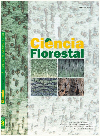
|
Ciência Florestal
Centro de Pesquisas Florestais - CEPEF, Departamento de Ciências Florestais - DCFL, Programa de Pós Graduação em Engenharia Florestal - PPGEF
ISSN: 0103-9954
EISSN: 0103-9954
Vol. 15, No. 4, 2005, pp. 343-357
|
 Bioline Code: cf05034
Bioline Code: cf05034
Full paper language: Portuguese
Document type: Research Article
Document available free of charge
|
|
|
Ciência Florestal, Vol. 15, No. 4, 2005, pp. 343-357
| pt |
PADRÃO E PROCESSO SUCESSIONAIS EM FLORESTAS SECUNDÁRIAS DE DIFERENTES IDADES NA AMAZÔNIA ORIENTAL
Araújo, Maristela Machado; Tucker, Joanna Marie; Vasconcelos, Steel Silva; Zarin, Daniel Jacob; Oliveira, Wilson; Sampaio, Patrícia Delamônica; Rangel-Vasconcelos, Lívia Gabrig; de Assis Oliveira, Francisco; de Fatima Rodrigues Coelho, Roberta; Aragão, Débora Veiga & Miranda, Izildinha
Resumo
A maioria dos estudos de sucessão em florestas secundárias na Amazônia avalia sítios de diferentes idades, que representam uma cronoseqüência sucessional, em vez de monitorar um único sítio por vários anos pelo inventário contínuo. Este estudo comparou a composição e estrutura florísticas de espécies arbóreas com diâmetro a 1,3 m de altura (DAP) ≥ 1 cm, em sítios com 4 e 12 anos na Amazônia Oriental, e avaliou a mortalidade e o recrutamento em ambos os sítios baseados em dados de inventário contínuo durante 4 anos de estudo. As áreas de estudo foram abandonadas após múltiplos ciclos de uso agrícola de 7 a 10 anos, desde ~1940. Ambos os sítios são dominados pelas espécies arbóreas Lacistema pubescens

e Vismia guianensis

, com densidade de indivíduos, diâmetro, altura, área basal e riqueza de espécies significativamente maiores no sítio de 12 anos. A densidade de indivíduos, ao longo do tempo, foi crescente no sítio de 4 anos e decrescente no de 12 anos; o diâmetro, a altura e a área basal aumentaram nos dois sítios. No sítio de 4 anos, foi constatada uma taxa de recrutamento líquido crescente entre 2000-2001 e 2001-2002, que diminuiu entre 2002-2003, indicando redução gradual na colonização. No sítio de 12 anos, foi observada alta mortalidade líquida (13 e 11%), sobretudo nas duas primeiras avaliações, indicando o processo de autodesbaste. A combinação dos métodos de cronoseqüência e inventário contínuo aumenta substancialmente o entendimento do desenvolvimento sucessional.
Amazônia; cronoseqüência; sucessão florestal; floresta secundária.
|
| |
| en |
SUCCESSIONAL PATTERN AND PROCESS IN SECONDARY FORESTS OF DIFFERENT AGES IN THE EASTERN AMAZON
Araújo, Maristela Machado; Tucker, Joanna Marie; Vasconcelos, Steel Silva; Zarin, Daniel Jacob; Oliveira, Wilson; Sampaio, Patrícia Delamônica; Rangel-Vasconcelos, Lívia Gabrig; de Assis Oliveira, Francisco; de Fatima Rodrigues Coelho, Roberta; Aragão, Débora Veiga & Miranda, Izildinha
Abstract
Most published studies of secondary forest succession in the Amazon examine stands of different ages that represent a successional chronosequence, rather than monitoring a single stand over the long-term. This study compares floristic composition and structure of tree species with diameter at 1.3 m height (DBH) ≥ 1 cm in a 4-year-old and a 12-year-old re-growth stand in the Eastern Amazon, and examines mortality and recruitment occurring within both stands based on repeated sampling carried out annually for four years. The study areas were abandoned after multiple agricultural cicles that lasted 7 to 10 years, beginning in ~1940. Both stands are largely dominated by the same tree species Lacistema pubescens

and Vismia guianensis

, with significantly higher stem density, diameter, height, basal area and species richness in the 12-year-old stand. In the 4-year-old stand there were measured an increase in annual net recruitment during the first two data collection periods but relatively lower net recruitment during the last evaluation period, indicating on-going but gradually weakening colonization. There were registered a high net mortality during the first two data collection periods in the 12-years-old stand with a relatively lower net mortality during the last evaluation indicating rapid self thinning. When used in combination, the chronosequence and the longitudinal approaches significantly strengthen the understanding of successional development.
Amazon; chronosequence; forestry succession; secondary forest.
|
| |
© Copyright 2005 - Ciéncia Florestal
Alternative site location: http://cascavel.ufsm.br/revistas/ojs-2.2.2/index.php/cienciaflorestal/index
|
|
